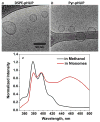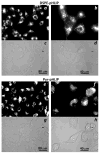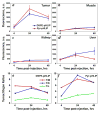pH-sensitive pHLIP® coated niosomes
- PMID: 28792261
- PMCID: PMC5658010
- DOI: 10.1080/09687688.2017.1342969
pH-sensitive pHLIP® coated niosomes
Abstract
Nanomedicine is becoming very popular over conventional methods due to the ability to tune physico-chemical properties of nano vectors, which are used for encapsulation of therapeutic and diagnostic agents. However, the success of nanomedicine primarily relies on how specifically and efficiently nanocarriers can target pathological sites to minimize undesirable side effects and enhance therapeutic efficacy. Here, we introduce a novel class of targeted nano drug delivery system, which can be used as an effective nano-theranostic for cancer. We formulated pH-sensitive niosomes (80-90 nm in diameter) using nonionic surfactants Span20 (43-45 mol%), cholesterol (50 mol%) and 5 mol% of pH (Low) insertion peptide (pHLIP) conjugated with DSPE lipids (DSPE-pHLIP) or hydrophobic fluorescent dye, pyrene, (Pyr-pHLIP). In coating of niosomes, pHLIP was used as an acidity sensitive targeting moiety. We have demonstrated that pHLIP coated niosomes sense the extracellular acidity of cancerous cells. Intravenous injection of fluorescently labeled (R18) pHLIP-coated niosomes into mice bearing tumors showed significant accumulation in tumors with minimal targeting of kidney, liver and muscles. Tumor-targeting niosomes coated with pHLIP exhibited 2-3 times higher tumor uptake compared to the non-targeted niosomes coated with PEG polymer. Long circulation time and uniform bio-distribution throughout the entire tumor make pHLIP-coated niosomes to be an attractive novel delivery system.
Keywords: Drug delivery; fluorescence imaging; targeting tumor acidity.
Conflict of interest statement
OA Andreev and YK Reshetnyak have founded and have a financial interest in a company, pHLIP, Inc., with the aim of bringing pHLIP technology to the clinic. The company has had no involvement in funding the studies reported here.
Figures






Similar articles
-
Decoration of Nanovesicles with pH (Low) Insertion Peptide (pHLIP) for Targeted Delivery.Nanoscale Res Lett. 2018 Dec 4;13(1):391. doi: 10.1186/s11671-018-2807-8. Nanoscale Res Lett. 2018. PMID: 30515583 Free PMC article.
-
Comparative Study of Tumor Targeting and Biodistribution of pH (Low) Insertion Peptides (pHLIP(®) Peptides) Conjugated with Different Fluorescent Dyes.Mol Imaging Biol. 2016 Oct;18(5):686-96. doi: 10.1007/s11307-016-0949-6. Mol Imaging Biol. 2016. PMID: 27074841 Free PMC article.
-
Pharmacokinetic modeling reveals parameters that govern tumor targeting and delivery by a pH-Low Insertion Peptide (pHLIP).Proc Natl Acad Sci U S A. 2021 Jan 5;118(1):e2016605118. doi: 10.1073/pnas.2016605118. Epub 2020 Dec 21. Proc Natl Acad Sci U S A. 2021. PMID: 33443162 Free PMC article.
-
Aiming the magic bullet: targeted delivery of imaging and therapeutic agents to solid tumors by pHLIP peptides.Front Pharmacol. 2024 Mar 13;15:1355893. doi: 10.3389/fphar.2024.1355893. eCollection 2024. Front Pharmacol. 2024. PMID: 38545547 Free PMC article. Review.
-
Targeting diseased tissues by pHLIP insertion at low cell surface pH.Front Physiol. 2014 Mar 13;5:97. doi: 10.3389/fphys.2014.00097. eCollection 2014. Front Physiol. 2014. PMID: 24659971 Free PMC article. Review.
Cited by
-
Recent Progress of Nanocarrier-Based Therapy for Solid Malignancies.Cancers (Basel). 2020 Sep 28;12(10):2783. doi: 10.3390/cancers12102783. Cancers (Basel). 2020. PMID: 32998391 Free PMC article. Review.
-
pH-responsive niosome-based nanocarriers of antineoplastic agents.RSC Adv. 2024 Apr 11;14(16):11124-11140. doi: 10.1039/d4ra01334d. eCollection 2024 Apr 3. RSC Adv. 2024. PMID: 38606056 Free PMC article.
-
Developing Actively Targeted Nanoparticles to Fight Cancer: Focus on Italian Research.Pharmaceutics. 2021 Sep 22;13(10):1538. doi: 10.3390/pharmaceutics13101538. Pharmaceutics. 2021. PMID: 34683830 Free PMC article. Review.
-
Current Advances in Specialised Niosomal Drug Delivery: Manufacture, Characterization and Drug Delivery Applications.Int J Mol Sci. 2022 Aug 26;23(17):9668. doi: 10.3390/ijms23179668. Int J Mol Sci. 2022. PMID: 36077066 Free PMC article. Review.
-
Lipid-Based Nanovesicular Drug Delivery Systems.Nanomaterials (Basel). 2021 Dec 14;11(12):3391. doi: 10.3390/nano11123391. Nanomaterials (Basel). 2021. PMID: 34947740 Free PMC article. Review.
References
-
- AMMAR H, GHORAB M, EL-NAHHAS S, HIGAZY I. Proniosomes as a carrier system for transdermal delivery of tenoxicam. International journal of pharmaceutics. 2011;405:142–152. - PubMed
Grants and funding
LinkOut - more resources
Full Text Sources
Other Literature Sources
